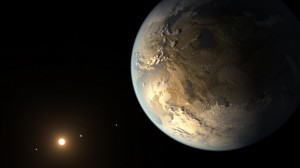15 January 2015
New studies give clues where alien life may flourish
Posted by Nanci Bompey
By Nanci Bompey

The artist’s concept depicts Kepler-186f, the first validated Earth-size planet to orbit a distant star in the habitable zone.
Credit: NASA
Earth-like planets orbiting distant stars, but bigger and older than our home planet, stand out as prime candidates to harbor complex life, according to new research.
“Super-Earths” up to five times the mass of Earth have oceans that could persist for at least 10 billion years, providing enough time for complex life to develop, according to Laura Schaefer and her colleagues at the Harvard-Smithsonian Center for Astrophysics in Cambridge, Mass. The scientists presented their findings, based on computer modeling, last week at the American Astronomical Society annual meeting in Seattle.
Separate observations of exoplanets — planets that circle stars other than our Sun — that were also presented at the AAS meeting, show that such planets less than 1.6 times the Earth’s diameter have the best chance of being “truly Earth-like.” This new assessment suggests that these rocky planets orbiting a modest distance from their stars are likely made up of the same ingredients as our Earth, making them good candidates for searching for complex life, according to Courtney Dressing and her colleagues, also from the Harvard-Smithsonian Center for Astrophysics.
Over the past 20 years, scientists have figured out that there are likely billions of planets orbiting stars in the universe and now are trying to determine which planets could harbor life, said Debra Fischer a professor of astronomy at Yale University who was not involved in the new research.
The Kepler telescope has discovered 4,175 Earth-like planets, and scientists announced last week at the AAS meeting that two newly discovered planets have sizes, locations and star types that make them especially good candidates for life.
Finding Earth-like planets helps scientists understand how life originated on our own planet, Fischer said. A better understanding of the compositions of planets and the factors that make them habitable are at the “very heart of why we are looking for exoplanets,” she noted during a January 5press conference about the super-Earths and smaller-diameter exoplanets that are promising candidates for life.
Scientists consider liquid water a necessary ingredient for the evolution of complex life. Oceans on Earth have existed for nearly the entire history of the planet, or about four and a half billion years, according to a press release from the Harvard-Smithsonian Center for Astrophysics. These oceans are maintained through what scientists call the deep water cycle: Water from the surface is forced into the Earth’s mantle through the movement of tectonic plates. After cycling through the mantle, the water returns to the surface through volcanic eruptions.
Computer modeling by Schaefer and her colleagues sheds light on how oceans might develop and persist on Earth-like planets in other solar systems. They find that Earth-like planets probably also recycle their water.
On planets about the same mass as the Earth and smaller, very deep oceans form early in the planet’s history, according to the new research. But those early oceans might cease to exist as water on the surface becomes trapped within the planet, making them poor candidates for complex life. Planets with masses up to two times the mass of Earth may lose some surface water to their interiors over time, resulting in shallow oceans on their surfaces at the end of their lifetimes, the new study indicates.
The thicker, cooler crusts of higher-mass planets slow the heat-driven process that brings water from the mantle to the surface, according to Schaefer. More massive planets have a larger delay, although their oceans could persist for billions of years. On planets that are five times the mass of Earth, the delay could be as much as a billion years before oceans form, possibly holding back evolution just as long. If life forms evolve on such planets at the same rate as they do here on Earth, those planets would have to be a billion years older than ours is to be at the same stage of developing complex life, according to the researchers.
“This suggests that if you want to look for life, you should look at older super-Earths,” Schaefer said in a statement.
For the work categorizing “truly Earth-like” exoplanets, also reported at the meeting, Dressing and her colleagues used the HARPS-North, or High-Accuracy Radial velocity Planet searcher, on the Telescopio Nazionale Galileo in the Canary Islands.
The team’s measurements of the sizes and masses of exoplanets suggest that Earth-like planets with diameters less than 1.6 times the Earth have a mass-size relationship similar to Earth and Venus. So, typical small exoplanets orbiting close to stars would likely have similar rock-iron compositions to our own planet and could be good candidates for searching for complex life, the team reported during the press conference.
“To find a truly Earth-like world, we should focus on planets less than 1.6 times the size of Earth, because those are the rocky worlds,” Dressing said in a statement.
— Nanci Bompey, AGU Public Information Specialist – Writer


 GeoSpace is a blog on Earth and space science, managed by AGU’s Public Information staff. The blog features posts by AGU writers and guest contributors on all sorts of relevant science topics, but with a focus on new research and geo and space sciences-related stories that are currently in the news.
GeoSpace is a blog on Earth and space science, managed by AGU’s Public Information staff. The blog features posts by AGU writers and guest contributors on all sorts of relevant science topics, but with a focus on new research and geo and space sciences-related stories that are currently in the news.